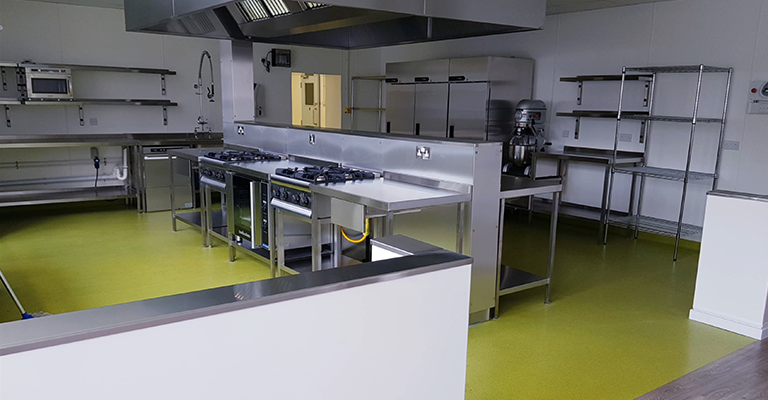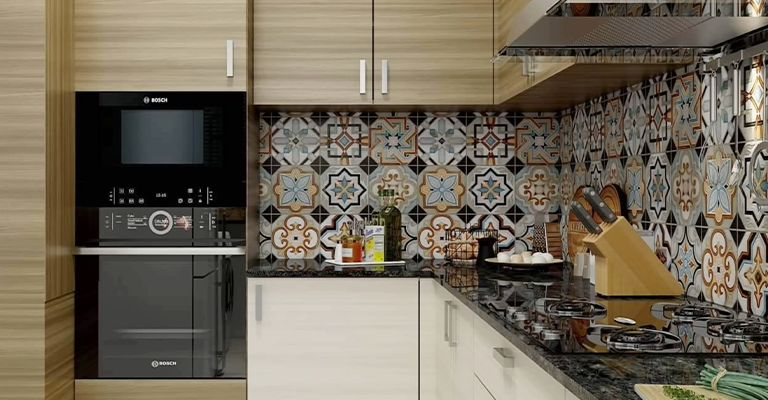What Is A Service Kitchen?-Unveiling the Heart of Culinary Excellence
A service kitchen, the bustling nerve center of professional culinary endeavors, is a meticulously crafted workspace designed for the artful orchestration of gastronomic creations on a grand scale.
Found in restaurants, hotels, and catering establishments, this specialized kitchen surpasses its domestic counterparts in scale, sophistication, and precision.
Equipped with an arsenal of industrial-grade appliances and tools, it transforms raw ingredients into delectable dishes, tailored to the unique demands of diverse culinary styles.
Yet, beyond its culinary prowess, a service kitchen upholds rigorous standards of hygiene and safety, ensuring the well-being of both its culinary artisans and discerning patrons.
In essence, it is the crucible where culinary dreams are forged into delightful realities.

What Is A Service Kitchen?
A service kitchen, also known as a commercial or professional kitchen, is a specialized workspace designed for the preparation of food on a larger scale, typically found in restaurants, hotels, catering facilities, and other food service establishments.
Unlike residential kitchens, service kitchens are optimized for efficiency, speed, and volume, as they are responsible for producing meals for numerous people.
Key characteristics of a service kitchen include:
Layout and Design
The layout of a service kitchen is meticulously planned to optimize workflow. It typically follows a “workflow triangle” principle, where the three main work areas (preparation, cooking, and cleaning) form a triangle to minimize unnecessary movement.
This layout ensures that chefs and kitchen staff can move efficiently between stations. Additionally, the placement of equipment is carefully considered minimizing congestion and facilitating easy access.
Equipment and Appliances
Service kitchens are equipped with a wide range of specialized appliances and tools. Industrial-grade stoves and ovens are designed for continuous, heavy use.
They often have multiple burners and ovens to accommodate the simultaneous cooking of various dishes. Deep fryers are built to handle large quantities of fried foods.
Commercial refrigeration units have precise temperature control to keep perishable goods at safe temperatures. In addition, high-powered food processors and slicers expedite prep work.
Storage
Storage in a service kitchen is divided into various categories. Walk-in refrigerators and freezers allow for ample storage of fresh and frozen ingredients.
Dry storage areas house non-perishable items like grains, canned goods, and dry spices. Additionally, separate storage areas may be designated for specific types of products, such as a produce room for fresh fruits and vegetables.
Sanitation and Safety
Maintaining a high standard of cleanliness and safety is paramount in a service kitchen. Stainless steel surfaces are favored for their durability and ease of cleaning.
Ventilation systems are designed to remove excess heat and fumes, while fire suppression systems are in place to quickly respond to emergencies.
Dishwashing stations are equipped with high-temperature sanitizing equipment to ensure that dishes and utensils are spotless.
Workstations
Each workstation in a service kitchen is equipped with the necessary tools and equipment for its specific tasks.
For instance, the prep station might have cutting boards, knives, and measuring tools, while the cooking station would have stove tops, grills, and fryers.
Pastry stations would be equipped with specialized tools for baking and dessert preparation. The layout ensures that chefs can efficiently move between stations as needed.
Staffing
The staffing of a service kitchen depends on factors like the size of the establishment, the complexity of the menu, and the expected volume of customers.
In addition to chefs and cooks, there may be specialized roles like pastry chefs, sous chefs, and kitchen assistants. Each member of the team plays a crucial role in ensuring the smooth operation of the kitchen.
Menu Execution
The design of a service kitchen is closely aligned with the menu it is expected to execute. For example, a kitchen focused on fine dining may have specialized equipment for techniques like sous vide or molecular gastronomy.
On the other hand, a more casual restaurant may prioritize a well-organized grill and fryer area. The kitchen’s layout and equipment are tailored to the specific demands of the menu.
Adaptability
Service kitchens need to be adaptable to accommodate changes in menu offerings, seasonal ingredients, and special requests.
This may involve having versatile equipment that can handle a range of cooking techniques and styles. Additionally, the layout should allow for easy reconfiguration to accommodate different workflows as needed.
Regulatory Compliance
Service kitchens must adhere to a host of regulations and standards set by local health departments and other regulatory bodies. This includes requirements for food handling, sanitation, and safety protocols.
Regular inspections and compliance with these codes are essential to maintain a safe and hygienic working environment.
13 Types of Service Kitchen

Service kitchens come in various types, each tailored to specific purposes and populations. These types of service kitchens include:
1. Senior Service Kitchens
These kitchens focus on providing nutritious meals to senior citizens, either at communal dining sites or through home-delivery programs. They often consider dietary restrictions common among seniors, such as low-sodium or diabetic-friendly meals.
2. Daycare and Pre-school Service Kitchens
Service kitchens in daycare and preschool facilities ensure that young children receive balanced and age-appropriate meals. They prioritize the nutritional needs of growing kids, offering meals that support their physical and cognitive development.
3. Assisted Living Facility Kitchens
These kitchens serve residents of assisted living facilities, where individuals require varying levels of assistance with daily activities. They provide specialized meals for seniors with specific dietary needs or medical conditions.
4. Community Center Service Kitchens
Community centers often house service kitchens that provide meals and support social activities for a wide range of community members. These kitchens promote social engagement and well-being among diverse age groups.
5. Home-Delivered Meal Service Kitchens
These kitchens focus primarily on preparing and delivering meals to homebound individuals who cannot access communal dining sites.
Home-delivered meal programs serve various populations, including seniors, individuals with disabilities, and those recovering from illness.
6. Hospital Service Kitchens
Hospitals have specialized service kitchens to provide meals to patients while considering their medical conditions and dietary restrictions. These kitchens play a crucial role in the recovery process and overall patient experience.
7. School Cafeterias
School cafeterias can also be considered service kitchens. They serve students nutritious meals that meet dietary guidelines, fostering healthy eating habits and supporting academic performance.
8. Catering Service Kitchens
Catering kitchens prepare and deliver meals for events, conferences, and parties. They focus on providing quality food on a larger scale and may offer customizable menus to meet specific event requirements.
9. Food Bank and Food Pantry Kitchens
Food banks and pantries often have service kitchens where volunteers and staff prepare food items for distribution to individuals and families in need. These kitchens contribute to alleviating hunger in communities.
10. Soup Kitchens
Soup kitchens primarily serve hot meals to individuals experiencing homelessness and food insecurity. They provide a basic necessity for those in crisis situations.
11. Corporate Cafeterias
Large companies and corporate campuses may have service kitchens in their cafeterias to offer employees convenient and healthy meal options during work hours.
12. Mobile Service Kitchens
Some organizations operate mobile service kitchens, such as food trucks, to reach communities in need, particularly during emergencies or in areas with limited access to traditional food establishments.
13. Community-Based Kitchens
These kitchens are established in collaboration with local communities and may serve specific cultural or ethnic groups, offering meals that reflect their culinary traditions and preferences.
Top 12 Essential Service Kitchen Tools and Equipment
A well-equipped service kitchen is crucial for efficient food preparation in commercial settings.
Here’s a top 12 list of common equipment and tools found in a service kitchen:
1. Commercial Oven
A reliable commercial oven is crucial for baking, roasting, and reheating a wide range of dishes. It should have the capacity to handle the kitchen’s cooking demands.
2. Stovetop and Range
Gas or electric stovetops and ranges with multiple burners or griddles are essential for cooking various dishes simultaneously, from sautéing to boiling.
3. Refrigerator and Freezer
Large-capacity refrigerators and freezers are vital for storing perishable ingredients, ensuring they remain fresh and safe for use.
4. Prep Tables
These tables provide ample workspace for food preparation. Refrigerated prep tables are especially useful for assembling salads and cold dishes.
5. Mixing Bowls, Pots, and Pans
A variety of sizes and types of mixing bowls, pots, and pans are necessary for cooking and preparing a wide range of dishes.
6. Cutting Boards and Knives
High-quality cutting boards and a selection of knives are essential tools for chopping, slicing, and dicing ingredients.
7. Food Processors
Food processors expedite prep work by quickly chopping, slicing, dicing, and pureeing ingredients in large quantities.
8. Dishwasher
Commercial dishwashers are vital for efficiently cleaning and sanitizing dishes, utensils, and cookware.
9. Food Warmers and Holding Cabinets
These appliances help keep prepared food at safe and consistent temperatures until it’s time for service.
10. Sinks and Cleaning Equipment
Commercial sinks, pot-washing sinks, and cleaning equipment are essential for maintaining proper hygiene and sanitation in the kitchen.
11. Food Thermometers
Accurate food thermometers are critical for ensuring that food is cooked to the right temperature and meets food safety standards.
12. Measuring Tools
Scales, measuring cups, and spoons are indispensable for precise ingredient portioning and following recipes accurately.
FAQs
What is a service kitchen?
A service kitchen is a specialized workspace designed for the preparation of food on a larger scale, commonly found in restaurants, hotels, and catering facilities.
What equipment can be found in a service kitchen?
A service kitchen typically includes industrial-grade stoves, ovens, grills, deep fryers, refrigeration units, and specialized tools for tasks like chopping and slicing.
Can a service kitchen handle different types of cuisine?
Yes, service kitchens are designed to accommodate various cuisines, with adaptable layouts and equipment to support different cooking techniques and styles.
What are some key safety considerations in a service kitchen?
Proper ventilation, fire suppression systems, regular equipment maintenance, and staff training on safety protocols are crucial in a service kitchen.
Do service kitchens have specific sanitation standards?
Yes, service kitchens must adhere to strict hygiene and sanitation standards, including regular cleaning schedules, proper food storage, and thorough handwashing practices.
To Recap
A service kitchen stands as the beating heart of any professional food service establishment, orchestrating the culinary symphony that culminates on diners’ plates. Meticulously designed and equipped, it caters to high-volume food production with precision and efficiency.
From fine dining to fast food, its layout and tools are tailored to specific culinary demands. Adherence to rigorous hygiene and safety standards is non-negotiable, ensuring the well-being of both staff and patrons.
With its adaptability, regulatory compliance, and commitment to excellence, a service kitchen is emblematic of the culinary industry’s dedication to delivering exceptional dining experiences, making it an indispensable cornerstone of the food service landscape.


